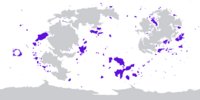Group of Island Nations: Difference between revisions
m (→Formation: spelling) |
mNo edit summary |
||
| Line 139: | Line 139: | ||
# {{flag|Giokto}} | # {{flag|Giokto}} | ||
# {{flag|Goankok}} | # {{flag|Goankok}} | ||
# {{flag|Hexanesa}} | # {{flag|Hexanesa}} | ||
# {{flag|Kolhar}} | # {{flag|Kolhar}} | ||
| Line 146: | Line 145: | ||
# {{flag|Llalta}} | # {{flag|Llalta}} | ||
# {{flag|Miiros}} | # {{flag|Miiros}} | ||
# {{flag|Mikochi}} | |||
# {{flag|Mitō}} | # {{flag|Mitō}} | ||
# {{flag|Niederoestereich}} | # {{flag|Niederoestereich}} | ||
Latest revision as of 14:27, 30 July 2024
 Logo | |
 Islands (dark blue) on Eurth. | |
| Abbreviation | GIN |
|---|---|
| Formation | May 19, 1974 |
| Founder | Kenkyō Declaration |
| Founded at | Kenkyō, Mitō |
| Legal status | Active |
| Purpose | Organisations of maritime nations |
| Headquarters | TBD (until May 2024) |
| Location |
|
Region | Eurth |
Secretary General | Mr/s $personName |
| Website | www.gin.org |
The Group of Island Nations (GIN) is a multinational organisation on Eurth. Its members discuss common socio-economical topics challenges as economic development, trade and shipping, ecology, fishing, etc. As island nations, the organisation's members share similar opportunities, concerns, and solutions which are markedly different from other, land-based Eurthican countries.[1]
Formation
The 1960s-1970s period on Eurth was a difficult time for many island nations. The Second Argic War (1968-1974) had many negative consequences, including rising energy prices and its effect on their shipping costs. The Group of Island Nations expected their combined influence could pressure the Oil Producing Eurthican Countries to again lower these energy prices. The first (informal) meeting took place in May 1974 in Mitō. It was the first international conference without continental powers, attended by King Tomasso from the Sunset Sea Islands and Michael Cancio from Salvia. They, along with a host of other heads of state and government, effectively amplified the plight of many islands' state of peril. They also vowed to no longer get involved in ‘Great War’ logic. The Kenkyō Declaration was an incredibly optimistic moment of fraternity, solidarity, and pacifism.[2] This resulted in the Group of Island Nations' formation and the appointment of its first secretary-general.[3]
Leadership
The Group of Island Nations is led by the Secretary-General. This person is appointed to a two-year term by a simple majority vote of the member countries. The Secretary-General is responsible for organising the conference. Current and previous Secretaries-General include:
- 1974: Mr/s $personName of
 Mitō
Mitō - 1976: Mr/s $personName of
 Sanctum Imperium Catholicum
Sanctum Imperium Catholicum - 1978: Mr/s $personName of
 Oyus (TBR)
Oyus (TBR) - 1980: Mr/s $personName of
 Sunset Sea Islands
Sunset Sea Islands - 1982: Mr/s $personName of
 Orioni
Orioni - 1984: Mr/s $personName of
 Llalta
Llalta - 1986: Mr/s $personName of
 Miiros
Miiros - 1988: Mr/s $personName of
 Seylos
Seylos - 1990: Mr/s $personName of
Gallambria
- 1992: Mr/s $personName of
 Safiloa (TBR)
Safiloa (TBR) - 1994: Mr/s $personName of
 Mitō
Mitō - 1996: Mr/s $personName of
 Sanctum Imperium Catholicum
Sanctum Imperium Catholicum - 1998: Mr/s $personName of
 Orioni
Orioni - 2000: Mr/s $personName of
 Oyus (TBR)
Oyus (TBR) - 2002: Mr/s $personName of
 Yosai
Yosai - 2004: Mr/s $personName of
 Andalla
Andalla - 2006: Mr/s $personName of TBD
- 2008: Mr/s $personName of
 Rhava (TBR)
Rhava (TBR) - 2010: Mr/s $personName of
 Mevraq (TBR)
Mevraq (TBR) - 2012: Mr/s $personName of
 Llalta
Llalta - 2014: Mr/s $personName of
Gallambria
- 2016: Mr/s $personName of
 Miiros
Miiros - 2018: Mr/s $personName of
 Mitō
Mitō - 2020: Mrs Miyo Okage of
 Esonice
Esonice - 2022: Mr/s $personName of TBD[4]
- 2024: 50th anniversary
Members
 Akwisia
Akwisia Alvernia
Alvernia Andalla
Andalla Apuni
Apuni Ayubi
Ayubi Bainbridge Islands
Bainbridge Islands Burkini
Burkini Damak Var
Damak Var Esonice
Esonice Florentia
FlorentiaGaellicia
 Galahinda
GalahindaGallambria
 Giokto
Giokto Goankok
Goankok Hexanesa
HexanesaKolhar
 Konalani
Konalani Kori-Chi
Kori-Chi Llalta
Llalta Miiros
Miiros Mikochi
Mikochi Mitō
Mitō Niederoestereich
Niederoestereich Orioni
Orioni Oyussa
Oyussa Rhava
Rhava Rohini
Rohini San Ba
San Ba San Giorgio
San Giorgio San Jorge
San Jorge Sanctum Imperium Catholicum
Sanctum Imperium Catholicum Seylos
Seylos Sunset Sea Islands
Sunset Sea IslandsTarua
 Yosai
Yosai
References
- ↑ Group of Island Nations (7 December 2018)
- ↑ Chapter 1: the Nakazima Declaration (8 May 2019)
- ↑ When life gives you lemons, make GIN and tonic (9 March 2019)
- ↑ OOC. The position of Secretary-General for 2022-2024 was proposed to Safiloa. Unfortunately, they left, so their candidacy is no longer considered canon.